Equip yourself with a high-performing portable air compressor to get the job done quickly and efficiently.
BobVila.com and its partners may earn a commission if you purchase a product through one of our links.
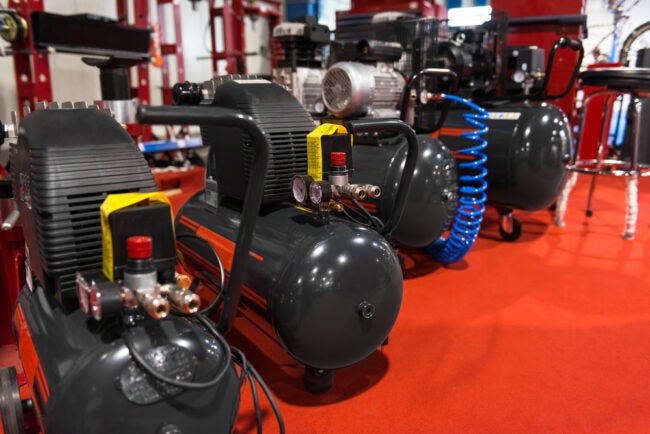
Photo: depositphotos.com
Pneumatic tools run by a portable air compressor can be a huge help and time-saver on a range of projects and at the construction site. Nail guns, for instance, drive fasteners with the pull of a trigger rather than pounds of a hammer. Impact wrenches can apply tons of torque and twisting power in seconds. Filling a truck tire will go from a nearly impossible task to a cinch with a tire inflator. All these tools use the pressure and volume created by an air compressor.
Air compressors squeeze air into a metal tank, which you can then use to power a tool. The best portable models are small, handy machines that help you make short work of your to-do list improving accuracy, workflow, and efficiency. Read on to learn what to look for in the best portable air compressor and why the following models are considered top of the line in their respective categories.
- BEST OVERALL: Makita MAC2400 Big Bore 2.5 HP Air Compressor
- BEST BANG FOR THE BUCK: Senco PC1010 1-Horsepower 1-Gallon Compressor
- BEST COMPACT: Metabo HPT Air Compressor 1-Gallon EC28M
- BEST LARGE CAPACITY: WEN 2202 20-Gallon Portable Air Compressor
- BEST WITH WHEELS: California Air Tools 8010A Air Compressor
- BEST GAS-POWERED: Industrial Air Contractor 4 Gallon Air Compressor
- BEST FOR THE CAR: TACKLIFE Portable Tire Inflator Air Compressor
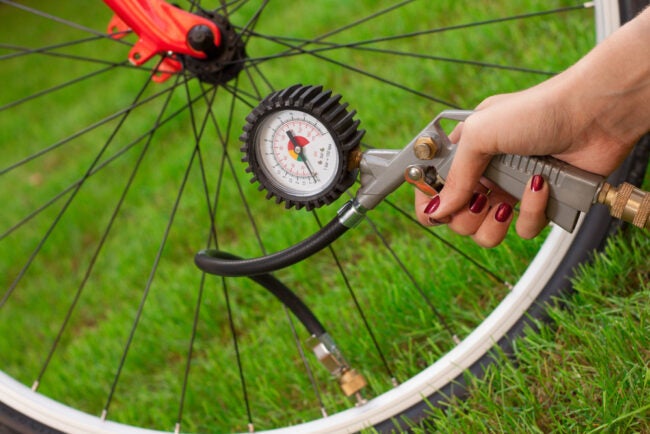
Photo: depositphotos.com
Before You Buy a Portable Air Compressor
Portable air compressors can be a tremendous help and open you up to a whole range of tools in the right DIY situation.
Portable air compressors must be fairly lightweight and compact so one person can pick them up, wheel them around, or lift them into the bed of a truck with ease. To create a small footprint (typically between about 25 and 70 pounds), manufacturers keep tanks small and use lighter-duty motors. While this is great for portability, it often comes at the sacrifice of volume and serviceability.
If you’re working in a shop scenario, you might be better off purchasing a larger air compressor to generate greater volume. Larger models tend to be simpler to service due to their larger, more robust parts that are easier to access, which may add to their life span.
Types of Portable Air Compressors
Before you purchase a portable air compressor, consider your power source. Portable air compressors run on either electricity or gasoline, each power source with its own pros and cons, explained below.
Electric
Electricity is the more popular power source for portable air compressors. These machines plug into standard outlets and use an electric motor to pressurize the tank. They’re usually reasonably lightweight, and electric motors require very little maintenance over the course of their lifetime.
Electric portable air compressors are a solid choice for home workshops and renovation projects, as there is generally an electrical outlet nearby to plug into. They don’t create exhaust, so you can use them indoors without worrying about carbon monoxide poisoning.
But electric compressors do have a few shortcomings. They usually aren’t serviceable, as the cost of replacing the motor, pump, and the necessary seals will often cost as much as buying a new compressor. Also, they can’t be used on construction projects that haven’t reached the electric phase, unless you run a heavy-duty generator to supply enough power.
Gas
Gas-powered portable air compressors use internal combustion engines to pressurize their air tanks. Much of their quality depends on the manufacturer of the gasoline engine, the best-known manufacturers being Honda, Briggs & Stratton, Kohler, Generac, Subaru, and Kawasaki.
Gas-powered compressors can operate virtually anywhere, as long as there’s fuel in the tank, though they tend to be a bit heavier than electric model compressors so are somewhat less portable. They also require more maintenance, as you’ll have to winterize them, check the oil, and replace fuel filters and spark plugs from time to time. While they are fine to use on outdoor construction sites and other places without power, they cannot be run inside a closed space, as these engines produce exhaust and you’d risk carbon monoxide poisoning.
What to Consider When Choosing the Best Portable Air Compressor
Now that you know which power source would best suit your projects, bone up on such important considerations as power, maximum pressure, and tank volume. Understanding how these aspects apply will help you choose the best portable air compressor for your needs.
Power
Air compressor motors are measured in horsepower ratings, and the machine’s power has a lot to do with its capability. While most air compressors have enough power for general needs, the more powerful the compressor, the faster it will fill its tank with air. Horsepower can also affect how much maximum pressure your compressor can produce. Small electric motors should have at least 1/2 horsepower, while gasoline-powered options can benefit from as much as 5-horsepower engines.
Again, it’s important to consider your power source. If you’re primarily working on renovation projects, an electric air compressor should suffice. If you’re taking your tools on the road to remote locations, it might be worth considering a gas-powered compressor.
Maximum Pressure
Portable air compressors have varying maximum pressures, which are measured in pounds per square inch (PSI). Some might pressurize to 120 PSI, while others can produce up to 150 or even as high as 180 PSI.
Maximum pressure is important to keep in mind because some tools require more pressure to work properly. For instance, most impact wrenches won’t operate until they reach 60 PSI or so. Some nail guns may also require a bit more pressure. While a nail gun may have a working range of 90 to 120 PSI, if you’re driving long nails into extremely wet or dense wood, you might need to be at the maximum pressure. That said, as a general rule, most compressors over 120 PSI will be fine for projects around the house or workshop.
Tank Volume
The volume of a compressor tank determines how much compressed air the machine can hold. It also determines how often the compressor will run, how long it will run for, and what you can do with your compressor.
Nail guns work with short bursts of air and so require very little volume—4- or 5-gallon tanks should be fine. Conversely, impact wrenches, cutoff wheels, and pneumatic reciprocating saws use much more air, as you hold their triggers down and let them run to do their job. For this reason, they require much larger tanks, or they will have to cycle on and off more often to maintain the tank pressure. In this case, 20-gallon tanks and larger are most helpful.
Airflow
Of all of the metrics manufacturers provide with their air compressors, airflow, may be the most important. Described as CFM (cubic feet per minute), this metric explains how much air the operating compressor can put out each minute while still maintaining pressure.
Essentially, you need a compressor that can run and maintain pressure for as long as you’re using your tool. If you drain the pressure out of the tank, you’ll have to stop and wait for the tank to rebuild enough pressure to operate your tool.
While the proper CFM rating for your needs will depend on the tools you plan to use, most of the CFM measurements provided are at 90 PSI. Look for compressors that can maintain at least 2.0 CFM at 90 PSI.
Weight
To be considered portable, an air compressor must be lightweight enough to lift into the back of a truck or onto a shelf or be wheeled about with ease.
Look for air compressors that you can lift easily. Generally speaking, pancake compressors—models that use round air tanks with motors atop—weigh about 30 pounds, making them a great choice for portability’s sake. Some double-tank compressors can offer more volume but weigh more than 70 pounds.
If you’re looking for a high-volume compressor but still want portability, check into a wheeled option. They come in both vertical and horizontal configurations and feature handles for wheeling them around.
Additional Features
Some additional features can help air compressors maintain durability or improve usefulness.
Built-in roll cages are steel or aluminum frames that protect the compressor. They’re especially helpful in scenarios where a portable compressor could fall from a truck tailgate.
Oil-cooled air compressors use oil to lubricate the compressor pump. This helps them stay cool, extending their life span. These models may include low-oil sensors that shut the machine down if there isn’t enough oil, which helps prevent the machine from running dry and overheating—two situations that could kill your compressor before its time.
Other additional features include easily operated petcock drain valves that allow you to drain your compressor’s water buildup easily, quick-connect adapters, and thermal overload protection.
Accessories
Occasionally, you’ll find an air compressor that comes with an accessory kit. This kit can be a great start if you don’t already have a myriad of air tools and fittings in your shop. These kits often come with tire inflators, quick-connect fittings, and blow-off chucks. You can sometimes get a kit with a length of air hose or a set of nail guns. There are sets on the market that include the tools and fittings you need to get up and running, significantly decreasing the amount of shopping one would have to do otherwise.
If the air compressor you have your eye on doesn’t come with a set of accessories, you can purchase a separate accessory pack that includes the basic tools necessary to set up your air compressor (available here).
Our Top Picks
With the types and shopping considerations outlined in mind, consider this list, which details some of the best portable air compressors on the market.
Best Overall
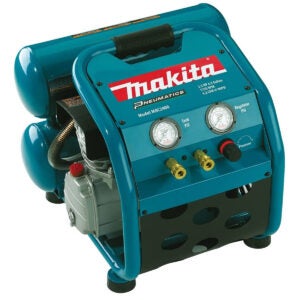
Makita’s MAC2400 Big Bore 2.5 HP Air Compressor features a twin stacked-tank design with 4.2 gallons of air volume. The motor has 2.5 horsepower and produces pressures up to 130 PSI and 4.2 CFM at 90 PSI. It has dual hose ports for running two tools at a time as well. The built-in roll cage provides insurance that an accidental drop or fall from a low height won’t take this compressor out of commission.
The MAC2400 isn’t oil-free, so you’ll have to keep an eye on the oil level during use. The benefit, though, is you’ll get a long-lasting compressor that runs at cooler temperatures.
Best Bang For the Buck
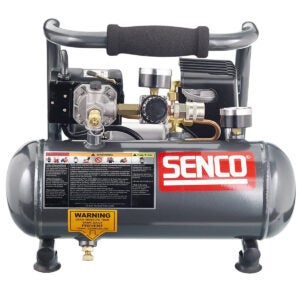
The Senco PC1010 is a compact compressor that produces enough pressure for most light-duty work, such as inflating tires and sports equipment, as well as operating finish nailers and small air-powered tools. This compressor has a 1-horsepower motor and a 1-gallon air tank, and it’s capable of producing up to 125 PSI.
The compressor is oilless and requires no maintenance. Senco designed the PC1010 to be extra quiet at roughly 73 dBs, and thanks to the aluminum tank and frame construction, it weighs a modest 20 pounds. With the machine’s foam-padded handle, it’s relatively easy to carry around.
Best Compact
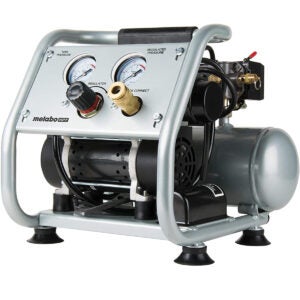
If you’re looking for a compact air compressor with some helpful features, the EC28M from Metabo HPT is worth a look. This compressor has a 1-gallon tank and a 1/2-horsepower electric motor that creates only 59 dB of sound. The Metabo HPT has a maximum pressure of 125 PSI and produces up to 0.8 CFM at 90 PSI.
The built-in roll cage protects it from falls or drops while also providing a rubber-padded handle for easy carry. It has one hose port, rubber feet for vibration dampening, and weighs in at 25.2 pounds. It will take up just over 1 square foot of space in your shop, plus it’s an oil-free, no-maintenance compressor.
Best Large Capacity
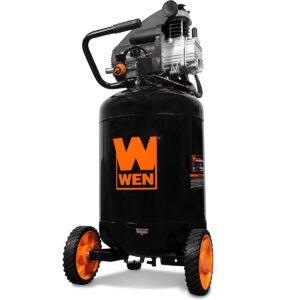
If you do a good deal of automotive work, you’ll want a compressor with enough volume to operate tools like impact wrenches and cutoff wheels. The 20-gallon 2202 from WEN might fill the bill, with its 135 PSI maximum pressure, 3.8 CFM rating at 90 PSI, and large tank. This oil-lubricated compressor has a 1.5-horsepower motor with an automatic pressure sensor to maintain pressure and shut off when it reaches the pressure.
The 2202 has a single hose port with a quick-connect fitting for a 1/4-inch hose. It weighs over 80 pounds but is portable via sturdy wheels as well as a built-in handle, so you can roll it around your shop or job site.
Best With Wheels
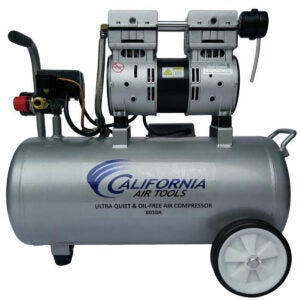
The California Air Tools 8010A is an 8-gallon horizontal compressor that can easily go where the work is. It has two rubber wheels and a handle, plus at 38 pounds it’s still potentially light enough for one person to lift it into a truck bed or carry it up a set of stairs.
The 8010A Air Compressor has a 2-horsepower motor that creates just 60 dB of noise, so using it inside a home or workshop with the doors closed shouldn’t be unbearable. It produces a maximum pressure of 120 PSI and 2.2 CFM at 90 PSI. California Air Tools designed the 8010A with a dual-piston pump system as well, to help improve longevity and performance.
Best Gas-Powered
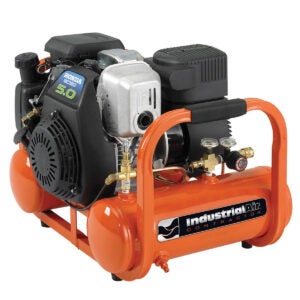
If you need to take a compressor off the grid, the Industrial Air Contractor 4-Gallon Air Compressor is a worthy contender. This gas-powered model features a 5-horsepower Honda engine that boosts the compressor up to 155 PSI and 5 CFM at 90 PSI—high for a portable model. The engine provides plenty of power while reducing fuel consumption and emissions over other gas-powered engines.
This compressor has two cushioned handles to make it easier to hoist up into a truck or carry up a set of stairs. Beware, however, that it weighs over 70 pounds, so it might be best to find a lifting buddy.
Best For The Car
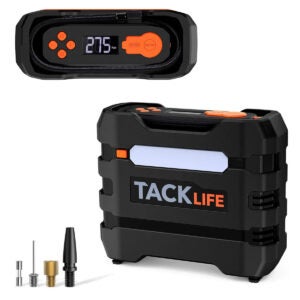
The TACKLIFE Portable Tire Inflator Air Compressor is a tankless air compressor that you can keep in your trunk for an emergency. It has a maximum pressure of 150 PSI, a built-in digital tire pressure gauge, and onboard storage for hoses and cords. The TACKLIFE features an LED emergency light with three modes: red, white, and SOS. It also comes with a carrying bag, a sports ball needle, and fittings for Presta and Schrader valves.
The TACKLIFE plugs into your vehicle’s 12V power supply and can fill a car or pickup tire from 20 PSI to 30 PSI in under two minutes. Be aware that this compressor most likely will not be able to fill a full-size truck tire.
FAQs About Portable Air Compressors
If a portable air compressor seems like it might be a big help for your projects but you still want more info, consider the answers to commonly asked questions below. For additional questions or concerns, reach out via your compressor’s customer service number.
Q. How does a portable air compressor work?
Portable air compressors use a motor to operate a piston. The piston draws outside air into a chamber and then stuffs it into a tank. It continues doing so until the pressure builds up enough to operate tools and inflate tires.
Q. How do you set up a portable air compressor?
Most portable air compressors come set up out of the box. If yours doesn’t, at most you’ll have to install a quick-connect on your hose port.
Q. How do you use a portable air compressor?
For electric compressors, simply plug it into an electrical outlet and flip the power switch on. Once the compressor builds up pressure, you can adjust the outlet PSI with a built-in pressure regulator to match your tool’s requirements.
For gasoline-powered compressors, fill the fuel tank and check that the engine has oil in it. Flip the power switch to the on position and pull the pull-start cord until it starts.
Q. Why do portable air compressors come in various shapes?
The different shapes of compressors aren’t really a functional design concern, so manufacturers can get creative with their designs. Sometimes separating the tank into two smaller tanks allows the compressor to have a lower center of gravity to aid in portability. Other times, the designs simply take up less space. For example, a horizontal compressor can fit under a workbench, while a vertical compressor fits better in a corner.
Q. How much air pressure do you need in a portable air compressor?
This really depends on the task. Bike tires and sports balls don’t require much pressure at all. On the other hand, pneumatic tools usually require 90 PSI or more to operate effectively. If you’re inflating something, you’ll find the maximum pressure written on the item near the inflation valve.
tinyurlis.gdv.gdv.htclck.ruulvis.netshrtco.detny.im
مقالات مشابه
- نظامی, Stolen Valor موارد در حال افزایش است محققان می گویند
- بیش از 210 پرسنل ارتش تست مثبت برای Coronavirus در دو آموزش پایگاه
- شرکت صادرات و واردات کالاهای مختلف از جمله کاشی و سرامیک و ارائه دهنده خدمات ترانزیت و بارگیری دریایی و ریلی و ترخیص کالا برای کشورهای مختلف از جمله روسیه و کشورهای حوزه cis و سایر نقاط جهان - بازرگانی علی قانعی
- سازمان دیده بان آنچه در تیم ما این است که پخت و پز در حال حاضر
- این ملوان نمی خواهند عشق خود را و یا پول است. این یک کلاهبرداری است و او یک قربانی بیش از حد
- شرکت صادرات و واردات کالاهای مختلف از جمله کاشی و سرامیک و ارائه دهنده خدمات ترانزیت و بارگیری دریایی و ریلی و ترخیص کالا برای کشورهای مختلف از جمله روسیه و کشورهای حوزه cis و سایر نقاط جهان - بازرگانی علی قانعی
- شرکت صادرات و واردات کالاهای مختلف از جمله کاشی و سرامیک و ارائه دهنده خدمات ترانزیت و بارگیری دریایی و ریلی و ترخیص کالا برای کشورهای مختلف از جمله روسیه و کشورهای حوزه cis و سایر نقاط جهان - بازرگانی علی قانعی
- B-1 بمب افکن ممکن است به ما قدرت نظامی در اقیانوس آرام
- تجهیزات و علوم آزمایشگاهی - مجله آزمایشگاهی لب ویکی
- شرکت صادرات و واردات کالاهای مختلف از جمله کاشی و سرامیک و ارائه دهنده خدمات ترانزیت و بارگیری دریایی و ریلی و ترخیص کالا برای کشورهای مختلف از جمله روسیه و کشورهای حوزه cis و سایر نقاط جهان - بازرگانی علی قانعی